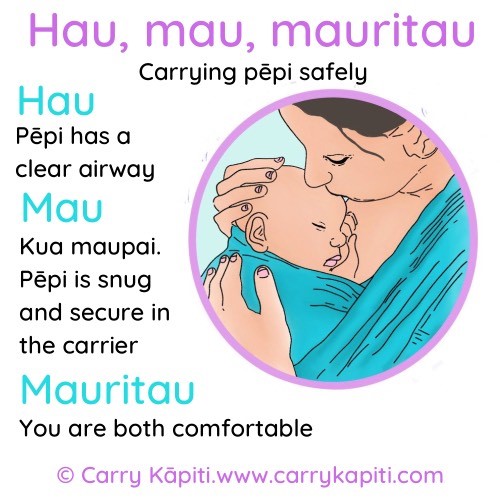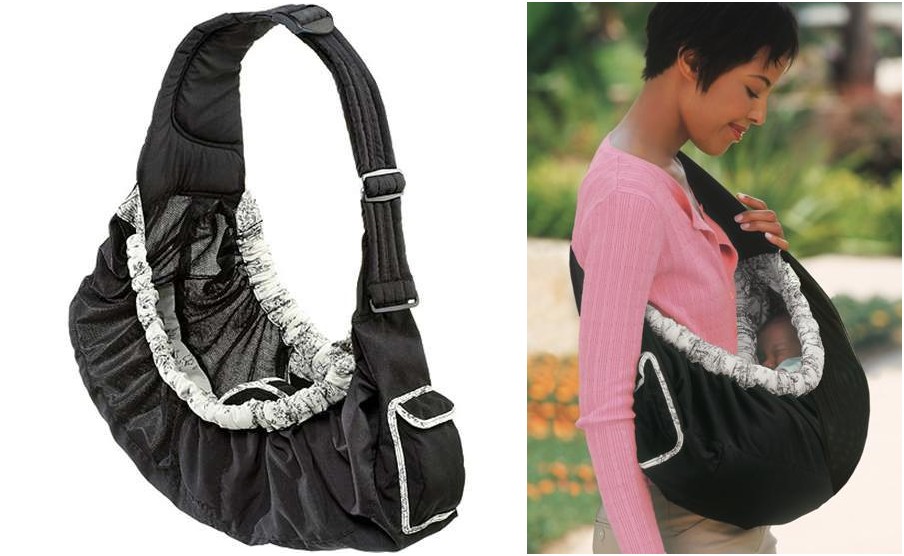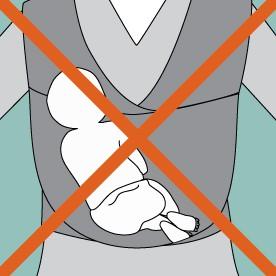Families around the world have carried babies since the start of time and generally speaking using a carrier is very safe! Choosing a safe carrier that is both the correct size for your baby and checking you use it safely will make your carrying journey safe and enjoyable.
However it is essential to understand what the risks are from babywearing so you take the time to read your carrier instructions and check it is on safely each time you use it.
There are two risks from carrying - Falls and Suffocation:
FALLS
Babies (and adults) are at risk of injury from falls from a carrier or from falling over while carrying. Some tips to avoid injury from a fall include the following:
- Ensure your baby is held close and tight in the carrier
- Ensure your carrier is correctly fastened - listen for the click of your buckle and use the safely elastics
- Always hold baby if you are leaning or bending to ensure baby doesn't fall out
- Adults should wear shoes that avoid tripping or slipping risk
- Avoid carrying your child in a position that obscures your view
- Check baby cannot slide out from your carrier's leg holes or incorect sling or wrap position
SUFFOCATION
Tragically a small number of babies have died from suffocation in a baby carrier, which is completely avoidable. This has occured from the baby's face not being visible and monitored, AND their airways being covered over or head position cutting off airways.
Here's how you can keep your baby's airways protected:
- Ensure the carrier is the correct size for your baby (most carriers are too big for newborns)
- Baby's face should be visible at all times
- Baby's face should be against the high, firm part of your chest (close enough to kiss)
- Do not cover baby's face during contact naps and monitor closely
- Always bring baby back to a high visible position immediately after breastfeeding
- Pay extra close attention to breathing and visibility if baby is unwell

Safety Essentials
-
Continually check that baby's airways are clear so there is no suffocation risk
-
Contact Naps (sleeping baby) in a carrier need constant monitoring
-
Always reposition baby back to an upright position immediately after feeding and retighten your carrier
-
Tighten the carrier securely so baby can't fall out
-
Baby is never covered by adult clothing or a blanket to avoid suffocation or overheating
-
Choose a carrier that is the correct size for your baby - one size fits all carriers are usually too big for newborns
TICKS Guidelines:
These are commonly used safety guidelines for babywearing developed by the UK Sling Consortium. The TICKS letters each stand for one way to keep your baby safe while using a sling, wrap or carrier. They cover the main ways to protect baby from the two key risks of babywearing - falls and suffocation.
These are especially relevant to carrying with newborns and focus on protecting baby's airways.

Unsafe positions
Thanks for Boba for these excellent images.
Safety points to note:
- You are still responsible for your baby at all times, not the carrier! You need to be able to monitor your baby at all times, see and feel their breathing.
- Only use a baby carrier in the upright position. Do not use a sling in the lying down cradle position as this can close your baby’s airway. Check regularly to ensure their chin is always off their chest to protect their airways.
- Never cover your baby with a blanket or adult clothing when in a carrier - Covering is a both suffocation and overheating risk that has resulted in the tragic loss of babies.
- Contact naps need baby's face uncovered and you continually checking on them.
- There are no New Zealand safety standards for baby carriers. Where possible, we recommend you always use a baby carrier that meets either the US or EU safety standard.
- Avoid buying carriers from Facebook Marketplace unless the seller can produce a receipt, as many carriers sold on there are fake.
- Always use a hand to support your baby if bending over to ensure baby does not fall out. Carriers are not designed for bending over hands free.
- The carrier should provide support for the baby’s body, hips and neck. The carrier should be tight enough that your child does not fall away from your body when you move, but not too tight that it straightens their spine or curves their spine towards you.
- Check your baby can breathe freely at all times with nothing covering their face - No part of the carrier, hood or an adult jacket should be over baby’s face.
- Avoid baby’s face being squished in the soft part of your chest or in bulky clothing. A good rule of thumb is that baby’s head is close enough to kiss without needing to bend.
- If you feed baby in the carrier, always reposition back to an upright position straight after feeding and tughten the carrier. It is a suffocation risk to leave baby contually feeding in the carrier, particularly in a reclined or cradle position.
- Make sure there are no points, sharp edges, choking hazards, small loops, clips, or buckles to trap small fingers and toes. Check your carrier regularly for ripped seams, sharp edges, and loose or missing buckles.
- Hold your baby over something soft — like a bed — when you are learning to use a carrier.
- Hoods should only be used with older babies on the back to support their head while sleeping. Care must always be taken if using a hood with a small baby – use the hood done up on one side only, ensure airways are not compromised and you can monitor your baby at all times.
- Check the size of the leg holes, to ensure your baby cannot slip out. This has been the cause of recalls in the United States.
- Only use a baby carrier the way you would carry your baby in your arms.
Bag Slings
DO NOT USE A BAG SLING!
These drawstring bag shaped slings are banned in many countries and the Ministry of Consumer Affairs in NZ has advised against their use. The baby can’t be placed in a safe position and can suffocate due to the design of the sling.

More information
Boba Wrap Safety, from the Boba website - click here



